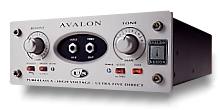
|
REVIEWS: From PROFESSIONAL SOUND June, 1999 |
|
AVALON DESIGN U5 Ultra Five Direct Instrument Preamplifier When I was assigned the task of writing a review on a Direct Box my first thought was, "how much can be said about a direct box?" I thought that I could sum up the operation of the average direct box within a few sentences. When the Avalon Ultra Five arrived on my doorstep, I quickly discovered that this was not your average direct box. Let's start with appearance. Like all of Avalon's products, the U5
is beautiful. It is two rack spaces high and half a rack space wide.
If you purchase two of the units they can be attached together and rack
ears can be installed to allow for easy mounting. The U5 does what all other direct boxes do; it converts instrument signals to microphone level signals. But unlike the average direct box, the U5 also converts high level speaker-amplifier signals to microphone level. Along with providing microphone level signals, the U5 also has a Line Level output. Both the microphone and line outputs run in tandem so the engineer can A/B both signals of a single source and choose which he prefers. Of course all of these outputs are fully balanced and pure Class A. Now beyond doing what most other high quality direct boxes should do. Here is a complete list of features that Avalon incorporates into the U5: - 100% discrete, pure Class A balanced signal path.
The features I found to be most interesting are: variable boost, speaker level input, and the six-bank tone control. By providing the variable boost control, Avalon has made it possible to match levels on various pieces of equipment. The gain control works in 3dB steps from +2dB to +32dB. I was easily able to match levels to my console from a wide range of instruments. A very low level acoustic guitar pick-up or a very high level keyboard output were both easily adapted by simply setting the gain control on the U5 prior to the console's microphone pre-amp. The only downfall I found with this feature was the fact that it worked in 3dB steps. I always prefer having a gain control that is sweepable instead of being in predetermined steps. But having a gain control at all on a DI is a great feature so I guess I shouldn't complain. At first, the speaker level input seemed to be a case of overkill and I couldn't think of a single time that I would require this feature. But since Avalon made it available I thought that I should test it. I ran an Ibanez electric bass through an SWR-Workingman 160 Bass Amplifier and connected the speaker output to the U5 and then connected the line level output to my console. The results were terrific; I had finally been able to take advantage of the full potential of this bass amplifier. In the past I had varying results from this amplifier's direct output; but now I was able to get the sound of the amplifier without having to mic a speaker cabinet. So, at first glance this feature seemed to be redundant but now I am convinced that it is the most power feature of the Avalon U5. The six-bank tone control is also a very useful feature. Avalon has provided six different equalization curves that can be put in the circuit. All of these "tonebanks" could be very helpful in situations where a predetermined EQ curve or sound is desired. All of these curves are very musical sounding and could come in very handy in a session where there is little time to spend on equalizing an instrument. I would, for the most part however, leave and equalization of the sound to my console and the mix session. Printing these EQ curves to tape could potentially paint you in a corner; however, they do have character that may add a great sound to your recording. I would also think that in a live sound situation these curves would be a great help. After trying the U5 on several instruments and in several different circumstances I must conclude that this is the "Mother" of all DI boxes. It is robust in both its sound and its construction; it allows for unheard of flexibility in a DI and is built with the highest of standards. While it is probably a bit too expensive for the semi-professional market it would make a great addition to any recording studio with the budget. I would also recommend this unit to session players that want to provide their clients with the highest level of quality. All in all I think that the Avalon U5 Direct Box is the best sounding direct interface box that I have heard.
Ron Skinner is the House Engineer for CBC Radio's Music Recording Studios in
Toronto. He also works as a freelance engineer/producer. Ron can be
reached by email at: heading_north@hotmail.com. Back to Reviews Index & User List |
Tel: +1 949 492
2000
©2023 Avalon Design USA LLC
 The
front panel plate is the standard Avalon Silver Alloy with the Avalon
Design Logo engraved on the right side. As I said before, this piece
of equipment is beautiful and if you clients are heavily into esthetics
they will certainly be booking your studio just to get a look at this
unit.
The
front panel plate is the standard Avalon Silver Alloy with the Avalon
Design Logo engraved on the right side. As I said before, this piece
of equipment is beautiful and if you clients are heavily into esthetics
they will certainly be booking your studio just to get a look at this
unit.